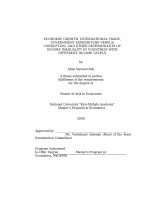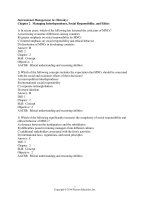(TIỂU LUẬN) INTERNATIONAL MANAGEMENT MANAGING ACROSS CULTURES analyze and provide examples of how difference in culture between countries can affect international management
Bạn đang xem bản rút gọn của tài liệu. Xem và tải ngay bản đầy đủ của tài liệu tại đây (237.96 KB, 11 trang )
VIETNAM NATIONAL UNIVERSITY
VNU UNIVERSITY OF ECONOMICS & BUSINESS
Faculty of International Business & Economics
INTERNATIONAL MANAGEMENT:
MANAGING ACROSS CULTURES
Course code: INE - 3223E*
FINAL ASSIGNMENT
Full name:
Phạm Thị Thanh Huyền
Student ID:
18050483
D.O.B:
05/09/2000
Class:
QH 2018E KTQT CLC1
Lecturers:
MA. Nguyen Thi Phuong Linh
MA. Dinh Van Hoang
Hanoi (05/2021)
PART 1: ESSAY
Analyze and provide examples of how difference in culture between countries can
affect international management?
In the context of a globally integrated economy, multiculturalism in an organization is
becoming more and more common. The different characteristics of cultures between
countries lead to diversity of thinking, understanding and communication. This leads to
cultural conflicts and can affect international management. Therefore, it can be affirmed
that cultural differences between countries really become an important factor, having a
great influence on the management strategies and human resource development of
enterprises.
The first is the influence of cultural differences on communication. Cross-cultural
communication has become extremely important for companies due to the growth of
global business, technology and the Internet. Understanding cross-cultural
communication is important for any company that has a diverse workforce or plans to
conduct business globally (Jack, B.M, 2008). The biggest problem in cross-cultural
communication is the language barrier. For example, an American flew to Japan to discuss
a potential partnership with a Japanese company. But Japan is a country with a relatively
low percentage of people knowing English, which means that the American guy has to
learn how to communicate effectively with the Japanese.
Communication is not only expressed through words. Gestures and eye contact are two
areas of nonverbal communication that are heavily used across cultures. Companies must
train employees correctly to handle nonverbal communication so as not to offend other
cultures (Theodor, R.L, 2006). For example, Americans tend to wave and use fingers to
point in communication to illustrate their words. But in contrast, in some other cultures,
especially Eastern cultures, pointing is considered an extreme and extremely rude gesture.
Besides, eye contact is also a form of non-verbal communication. In the US, eye contact
is a good thing and is considered a reflection of honesty and straightforwardness.
However, in some African, Asian, and Middle Eastern cultures, prolonged eye contact can
be seen as rude or aggressive in many situations.
The second is the effect of cultural differences on motivation. The types of motivations
and incentives considered vary across cultures. For example, most Japanese managers
expect their employees not to be paid extra to stay at work late, and overtime has become
a requirement of the job. There is recent evidence that Japanese workers can do more work
in a working day than the normal amount of work. Or in recent years, the number of annual
hours worked by German workers has decreased, while the number of Americans is
increasing. Germans place a high value on lifestyle and often prefer leisure to work, while
2
their American counterparts are quite the opposite. Thus, we can clearly see that a wide
range of wages (large wage disparities) in American companies compared to German
companies create incentives for American employees to work harder.
The third is the influence of cultural differences on competitiveness. There are cultures
where managers encourage competition among employees to promote accountability and
creativity. But there are cultures, where managers encourage cooperation and focus on
creating a harmonious and favorable working environment for employees. With a highly
competitive environment, work will be done quickly, planning will focus on the results of
the plan implementation. With a cooperative environment, the implementation of the plan
will be sociable, everyone will discuss with each other during the implementation of the
plan, will add and amend in time, the quality of work will be improved. For example, in
the work environment and Western countries, they emphasize individual independence,
always encourage competition and focus on developing personal achievement. On the
contrary, Eastern cultures, typically Japan, place great importance on and are always
oriented towards the collective, that is, they consider the goal of the collective as the
highest development goal.
The fourth is the effect of cultural differences on leadership. As for the hierarchy, the
leader behaves in a way that reflects their important role in the organization, and the
employees are familiar and comfortable with their immediate supervisor. The biggest
negative point here is that when there is regular and continuous supervision in parallel
with the employee's working process, it will initially make employees feel afraid, work
pressure, even have problems. disagree with superiors. However, with such supervision
employees will work seriously. In many other societies, managers have an open mind,
they actively exchange ideas with their subordinates, making the relationship between the
two sides always harmonious, reducing feelings of apprehension and becoming more
confident when expressing their views and opinions. Depending on the country and
culture, the role of leaders in the workplace can vary. The role of a leader and its
importance can greatly influence work motivation, interaction, and expectations in a team.
For example, the importance placed on the hierarchy and the hierarchy of a company is
very common in Latin American and Asian cultures. In these cultures, leaders play a more
dominant and defined role. Subordinates address them in a very specific way and often
don't challenge what they say. This dynamic greatly influences how a leader and/or boss
interacts with their team, ultimately affecting all other aspects of management.
Culture can be defined as a way of life of people that is influenced by their values, beliefs,
attitudes, arts and sciences, modes of perception, thinking and functioning. Cultural
difference can be understood as the fact that between two or more cultures have different
or even contradictory values, creating unique features that make it possible to distinguish
3
between cultures. In this way, culture explains how an individual lives and behaves in an
environment and how their thoughts and perceptions are construed to influence the mutual
relationship between the individual and the environment in which they live. So cultural
differences between countries really have a profound effect on international management.
PART 2: CASE STUDY ANALYSIS
1. Analyze the advantages and problems associated with managing a diverse and
multicultural workforce.
Corporate culture is the catalyst for business success. Owning a diverse and multicultural
workforce greatly affects the development of the business.
First, diverse cultural perspectives can inspire creativity and spur innovation. Culture
affects the way people see the world. In other words, people from different cultures will
see the world in different ways. They are raised to have different views, different beliefs,
and they use different methods to get their jobs done.
Diversity of thought has been shown to spark creativity and drive innovation, helping to
solve problems and meet customer needs in new and exciting ways. Multiple voices,
perspectives, and personalities arising from many people can create out-of-the-box
thinking. And cultural diversity will contribute to fostering innovation in the business.
This innovation stems from the ability to approach problems and find solutions from
different perspectives. When you have a team of employees with different skills, life
experiences and cultural backgrounds, businesses will reap a lot of new and creative ideas.
By providing a platform for the open exchange of ideas, businesses can leverage the
strengths of each individual, thereby bringing them together towards a common goal,
creating new the greatest benefit of diversity in the workplace.
There's been a lot of research demonstrating this positive side of workplace cultural
diversity. A recent study from Forbes concluded that "The best way to ensure the
development of new ideas is through a diverse and inclusive workforce.”1. In addition, the
Harvard Business Review conducted an experiment to determine how six different groups
responded to new, uncertain, and complex situations. As a result, the groups that scored
the highest had more cognitive diversity than those that took longer or didn't complete the
challenge, and the researchers concluded that higher cognitive diversity could lead to
performance higher and learn faster. These factors spark creativity and innovation.
Second, having in-depth knowledge and understanding of a locality as well as its people,
environment and market will make a business more competitive and profitable. A
multicultural workforce can give an organization an important advantage when expanding
1
Forbes Insights. (2011). Global Diversity and Inclusion: Fostering Innovation Through a Diverse Workforce.
4
into new markets. Often, a product or service needs to be researched and adapted to
succeed in a foreign market. Thanks to a team of multicultural, knowledgeable and local
staff, you will spend less time and effort on market research and target market
identification Having a workforce that understands local laws, regulations and customs,
as well as the competitive landscape, can help a business save resources, thereby focusing
on product research, making suitable strategy for foreign markets. This has been
corroborated by McKinsey research, which shows that companies in the top 25% for racial
and ethnic diversity are 35% more likely to achieve above-average financial returns. For
gender diversity, that number is 15%. And companies in the bottom 25% in terms of
diversity were less likely to achieve above-average results2. Furthermore, connecting with
local people, knowing the local language and understanding their customs and culture can
exponentially boost international business development.
Third, an organization with a diverse and multicultural workforce will result in higher
productivity and better performance. Because people have different experiences, different
expertise and different working methods, an organization can have many perspectives
from different sides of the problem. On that basis, they find the fastest and most effective
solution. As a result, the organization's problem-solving capacity is enhanced, leading to
higher productivity and work performance. In fact, many studies have shown that
organizations with diverse and multicultural workforces are better able to solve complex
problems, while also exhibiting greater creativity and broader innovation range of
thinking3.
On the other hand, diversity in the workplace can create healthy competition, excellent
individuals can motivate and pull the whole team to work effectively and actively to
achieve common goals. This healthy competitive atmosphere can help improve the ability
of individuals to learn, work and experience, thereby improving the morale and
performance of the whole team. On that basis, projecting cultural diversity in the
workplace will lead to the optimization of company processes for greater efficiency.
Ultimately, cultural diversity in the workplace offers greater opportunities for personal
growth. Working in an environment of diverse cultures, being exposed to people from
different countries will be an extremely interesting and enriching experience. This
opportunity allows everyone to actively reach out and learn about perspectives, cultures
and traditions from around the world. Having a lot of knowledge about different cultures,
learning a lot of different experiences and working methods as well as making many
connections not only helps people open up new and broader approaches, different, more
efficient. From there, they can be more favorable in their work together and also open up
2
3
Vivian & Prince, S. (2015). Why diversity matters. McKinsey & Company Organization.
Justin Grey. (2013). Study finds diverse, inclusive workplaces more productive. My Business
5
new opportunities for personal development. Besides, thanks to the diversity and
multiculturalism in the organization, people can connect more together based on
similarities and understand each other better from differences, which can help them
become one global citizenship, abandoning prejudices or negative views about the
national worldview.
Thus, owning a diverse and multicultural workforce brings a lot of outstanding benefits to
the organization in general and the individual in particular. And if managers can manage
their multicultural team well, the business of the enterprise will develop more and more
effectively.
Despite its many benefits, managing a diverse and multicultural team also has a lot of
problems that need to be addressed.
First, integration among a diverse and multicultural group can be extremely difficult in
the face of negative cultural stereotypes. This can be an insurmountable challenge,
especially if there are hidden prejudices between different cultures in the group, which
will make individuals less inclined to want to work together and work together. mutual
support. Not only that, negative cultural stereotypes can be seriously detrimental to the
entire team. This can drag down the morale of the whole company, make the working
atmosphere lack harmony and cohesion, thereby reducing productivity and work
performance, negatively affecting the common goal. And it's safe to say that prejudice is
absolutely a serious concern, as deep-rooted and unconscious cultural biases can be a
daunting challenge for managers with diverse workforces.
Second, the language barrier is one of the difficulties for both employees and managers.
Not to mention that each individual from different countries will speak different
languages, because when working in the same group, they will have to communicate in
the same language. But since people come from many parts of the world, it becomes
extremely difficult to understand a wide range of accents or understand idiomatic usage
by native speakers. And that of course will greatly affect the process of exchanging and
working together, which can drag down productivity, making work inefficient.
Besides, communication is not just words. Nonverbal communication is also a common
aspect of cultural interaction. In different cultures, people have different ways of nonverbal communication. For example, in the US, when communicating, people tend to
wave and use their fingers to point when they want to express their views. In Japan,
however, pointing is considered extremely rude and extreme. Thus, differences in
communication styles between cultures can lead to misunderstanding or even insult
(though not intentionally) between team members from different countries, causing
disunity and lack of harmony in the organization.
6
Finally, despite its positive connotations, different working styles among individuals in
an organization can cause conflicts between groups. With different cultures, working
styles and attitudes towards work can be very different, reflecting cultural values and
complex differences. For example, in the work environment and in Western countries,
they emphasize individual independence and focus on developing personal achievement.
On the contrary, Eastern cultures, typically Japan, place great importance on and are
always oriented towards the collective, that is, they consider the goal of the collective as
the highest development goal. Thus, if not recognized and calculated, conflicting
approaches can seriously affect the overall relationship in the organization, causing a
decrease in productivity and management performance as well as the operation of the
whole company.
2. What is P&G doing to develop and support a diverse workplace?
The Procter & Gamble Company (P&G) is an American multinational consumer goods
corporation headquartered in downtown Cincinnati, Ohio, founded in 1837 by BritishAmerican William Procter and American Irish - James Gamble. The group specializes
in a wide range of personal health, consumer health products and personal hygiene
products.
In 2019, P&G was ranked 22nd on DiversityInc's Top 50 Companies, recognized as the
nation's leading companies for diversity and inclusion management. The companies on
this list all have solid records in areas such as recruiting, retaining and promoting
women, minorities, people with disabilities, LGBT and veterans. On May 1, P&G
appointed a new director of diversity and inclusion. The company was also recently
ranked by Working Mother magazine as one of the 10 best companies of 2019 for
multicultural women. As such, it is clear that diversity means a lot to P&G and that it
has also put a lot of effort into developing and supporting diverse workplaces within its
organization.
P&G's global workforce is a mix of people from more than 145 nationalities. P&G
places great emphasis on the importance of diversity in the workplace. That is why they
are so keen on attracting, recruiting and retaining cross-cultural employees in their
organization. That can help P&G better understand cultures, see the world through
different perspectives, help them better understand their target markets and consumers.
It can be said that upholding strong values of diversity within the organization and
driving action externally allows the company to win the hearts of consumers around the
world. With the goal “Everyone is valued. Everyone is integrated. Everyone is working
at their best.” P&G helps all employees develop to their full potential. To this end, the
company has HR systems that support personal development, and P&G regularly
reviews these systems to make sure they work for everyone, including women. and their
minority working groups. Ongoing support systems P&G already in place include:
7
Career discussions, performance appraisals, assignment plans, transfer and
promotion plans.
Grass roots/informal network support groups which have existed at different sites
for a number of years.
Mentoring, to provide informal support and guidance, in addition to coaching and
training provided by each employee’s direct manager.
In addition, every year in the United States, P&G proudly celebrates the world's rich
cultures during Black History Month, Hispanic Heritage Month, Gay Pride Week, and
Gay Pride Week. Diversity & inclusion, etc. The purpose of their above activities is to
honor employees, bring more satisfaction to more consumers, solve problems better and
ultimately grow the company.
P&G builds its culture on values, behaviors and norms that create an advantage from
being different. P&G is becoming increasingly diversified and growing worldwide.
More importantly, P&G respects and values each individual in the team. The working
environment of this group always promotes and encourages cooperation, on the basis of
which, honoring talents and exploiting different experiences together to create better
ideas and services, superior product.
PART 3. COURSE REFLECTION
What did you learn from the course? How do you intend to apply this knowledge in
the future?
At the end of the course, I learned a lot about people in organizations around the world,
with diverse influences from different cultures. Not only that, I also learned a lot of
knowledge from real-life examples of cross-cultural management experience,
international management, human resources in the context of international integration
and the impact of cultural diversity becomes increasingly important. If I have the
opportunity to work in global businesses in the future, I believe it will be a very
rewarding and enjoyable experience. So I can use the knowledge and skills I have to
operate and develop myself.
How did your group organize group assignment? How did you divide up tasks? How
did you interact with your group colleagues? Did you work cohesively? How did you
rate your performance, particularly in comparison with your group members? What
would you have done differently?
To organize the subgroup, we unanimously elect a leader and agree to follow his or her
instructions. As updated thread, our team members, I always try to follow the
instructions of the head and division of work. Of course, sometimes we still have some
personal problems at work, but the team members will always help and support each
other to accomplish the common goal.
8
Interacting with team members is not difficult but it is not easy for everyone to agree on
an idea. Therefore, I have chosen to listen to people before disagreeing with their
opinions and ideas gathered to accomplish a common goal. The important thing I learned
here is to respect people first if you want to be respected. So I think I did my best to
keep up my team spirit.
I measure my performance by completing on time and the quality of my work is verified
by all team members. I don't want to compare myself to everyone on the team but
learning from their strengths has always been my top priority. If I could do something
different, it would only correct the remaining weaknesses in myself.
What did you learn from learning online?
I realize there are many advantages to online learning but there are still problems. The
advantages that I like the most are the initiative in terms of time. We do not need to
move to a fixed location to study but can study at home, avoiding being late. Online
learning also helps me access practical information, useful knowledge shared from many
sources in the classroom. We can work in groups, complete tasks, projects or do research
online without having to meet in person.
But actually, I still prefer going to school. I really miss my school, my teachers and my
close friends
Do you have any recommendation to the lecturer? If yes, please specify.
I think our lecturer s have done an excellent job of imparting course knowledge to
students. Thanks to the guidance of Master Nguyen Thi Phuong Linh and Master Dinh
Van Hoang, I have gained a broader and more realistic view of this subject and cultivated
the knowledge and skills to work in the future. Through this course, I realized what I
lacked and also what I need to do to improve myself.
To the lecturers, from the bottom of my heart, I would like to thank the two teachers for
their dedicated guidance. Hope that my beloved lecturers in the future will always be
happy and successful. Wish you all the best!
9
REFERENCES
1. Bennis, C.C., Nanus. (2005). Cross-cultural value applications. Bangkok
2. Forbes Insights. (2011). Global Diversity and Inclusion: Fostering Innovation
Through
a
Diverse
Workforce.
Retrieved
May,
2021
from:
/>sity.pdf
3. Jack, B.M. (2008). Cultural intelligence: People skills for global business. San
Francisco.
4. Justin Grey. (2013). Study finds diverse, inclusive workplaces more productive.
Retrieved
May,
2021
from
My
Business:
/>5. Katie Reynolds. (2019). 13 benefits and challenges of cultural diversity in the
workplace.
Retrieved
May,
2021
from
HULT
Blogs:
/>6. Kingery, N. (2019), P&G again ranks among top companies for diversity.
Retrieved
May,
2020
from
Cincinnati
Business
Courrier:
/>7. Procter &Gamble. (1998). Diversity. Retrieved May, 2020 from
/>g_toolbar/download_report/diversity.pdf
8. Reynolds, A. & Lewis, D. (2017). Teams Solve Problems Faster When They’re
More Cognitively Diverse. Retrieved May, 2021 from Harvard Business Review:
/>9. Theodor, R.L. (2006). Inference of attitudes from nonverbal communication in
two channels.
10. Vivian & Prince, S. (2015). Why diversity matters. Retrieved May, 2021 from
McKinsey & Company Organization: />11. Vji, V. (2018, November 19). How P&G Prioritizes Diversity, Inclusion and
Gender Equality to Create Global Impact. Retrieved May, 2020 from Triple
Pundit: />
10
11









